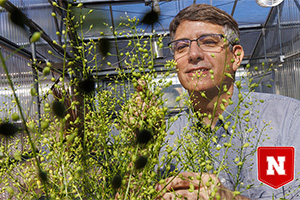By Nebraska Today

For several decades, researchers have explored how to repurpose the active ingredients of sex pheromones — chemicals released by insects and other organisms to attract sexual partners — for the sake of trapping insect pests or disrupting their reproduction. But producing synthetic versions of those pheromones on a commercial scale remains expensive enough that only growers of orchard fruit and other high-value crops can afford it.
In a poetic twist, researchers have since pivoted to other plants, including oilseed crops, that naturally yield chemical precursors of those insect pheromones and can be engineered to yield even more.
Led by researchers at Lund University, the Swedish University of Agricultural Sciences and the California-based ISCA Inc., DWFI Faculty Fellow Ed Cahoon and Tara Nazarenus joined an effort to optimize the natural pheromone-part factories. They focused on Camelina sativa, or camelina, the sort of oilseed crop that Cahoon has devoted years to studying.
Even in its current form, the team’s oilseed-based processing of pheromones would likely cost less than producing synthetics. Streamlining that processing, and further reducing costs, could put pheromones within reach of farmers who grow corn, soybean and other high-volume crops, the team said.

